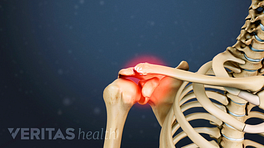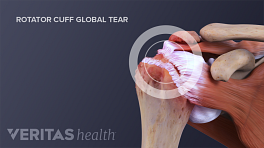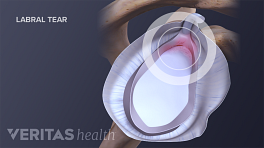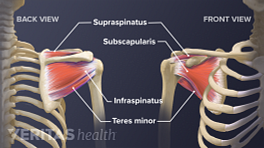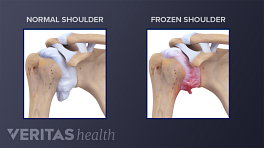A shoulder dislocation occurs when the humeral head is forced out of its position in the socket of the shoulder joint.
In This Article:
- Shoulder Dislocation Injury (Dislocated Shoulder)
- Dislocated Shoulder Symptoms
- Causes and Risk Factors for a Dislocated Shoulder
- Diagnosing a Dislocated Shoulder
- Treatment for a Dislocated Shoulder
- Surgery for Dislocated Shoulder
Traumatic Events Cause Most Dislocations
A traumatic event, such as a blow to the shoulder or a fall, is the most common cause of a first-time shoulder dislocation. The resulting dislocation is nearly always an anterior dislocation, in which the humeral head moves out the socket to the front of the body.
Shoulder dislocations most commonly occur in teenage boys and young men in their 20s because they tend to engage in the physical activities that raise risk for a dislocation, such as playing a contact sport like hockey or football. Sports that have potential for frequent or high-impact falls, such as gymnastics or downhill skiing, can raise risk too.
Outside of sports, car accidents and falls are often causes of a dislocated shoulder. An epileptic seizure and electrocution may also trigger a posterior (to the back) dislocation, as muscles in the front of the shoulder contract forcefully. Shoulder dislocation is also a common complication after a stroke as a result of paralysis on one side of the body.
Risk Factors for Shoulder Dislocation
Apart from participation in contact sports, there are three factors that can make the shoulder joint more vulnerable to dislocations:
1. Repetitive overhead movement
Repetitive shoulder motion can cause the ligaments surrounding the shoulder’s socket to stretch. Weakened and stretched shoulder tissue from repetitive movement can leave the shoulder joint less stabilized, which may lead to shoulder instability.
Shoulder instability due to repetitive use is sometimes referred to as a microtraumatic dislocation. Those at risk for a microtraumatic dislocation include participants in sports with a lot of overhead motion, including swimming, volleyball, and baseball.
2. Previous dislocation
After the first dislocation, the shoulder is much more vulnerable to a recurring dislocation—especially for younger patients. In fact, some estimates show that patients younger than 20 have a recurrence rate up to 90%.
1
Pedowitz R, Chung CB, Resnick D. Magnetic Resonance Imaging In Orthopedic Sports Medicine. Springer Verlag. (2008) ISBN:0387488979.
The first dislocation can stretch the tissues surrounding the shoulder joint, causing the shoulder to be unstable and result in another dislocation. The medical term for repeated shoulder dislocations is chronic shoulder instability.
3. Genetics
Some people naturally have more lax, malleable connective tissues in the body, including those who may be referred to as “double jointed.” They may experience a shoulder dislocation without substantial injury or pain. These people may also be more likely to experience subluxations (partial dislocations) in which the joint slides back into place by itself. Many people with this condition or generalized laxity learn how to move the shoulder back in place themselves.When a shoulder dislocation occurs, it is best to have it moved back into place (reduced) by a physician. Since most dislocations occur during contact sports, this should be a consideration for coaches, parents, and athletes alike.
- 1 Pedowitz R, Chung CB, Resnick D. Magnetic Resonance Imaging In Orthopedic Sports Medicine. Springer Verlag. (2008) ISBN:0387488979.

